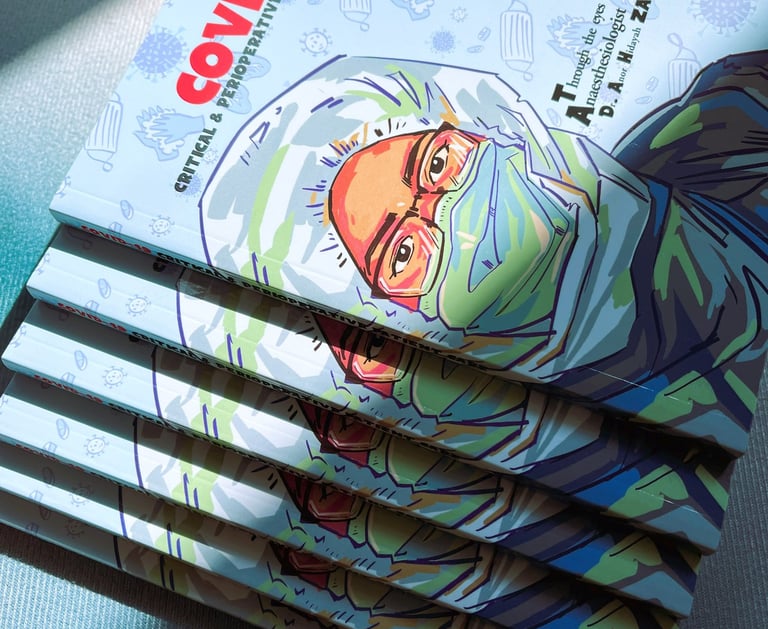My Stories
Through The Eyes of An Anaesthesiologist
We have made quality of our habit. It’s not something that we just strive for – we live by this principle every day.



This book is about the journey of surviving through COVID-19 pandemic in the year of 2000 until 2022.
The frontiers of COVID-19 Critical care patients’ management.
The silent struggle to save lives from the end of breath and sustaining every heartbeat of our patients.
From the blood and sweets of two years managing COVID-19 and its challenges.
From the eyes of an Anaesthesiologist and the critical care team…
My life experience worth sharing.
The Why Question
I’ve been working for more than a decade as a doctor….. I work as an Anaesthesiologist.
Who is an Anaesthesiologist?
Anaesthesiologist is an expert with extensive knowledge of human physiology and the pathology of organ systems both under normal and stress conditions. They are trained to mechanically and pharmacologically influence the human body system and be able to support patients in critical care and peri-operatively to prepare for surgical procedures under various medical conditions.
Why do I love working as an Anaesthesiologist?
My responsibility is to ensure patient safety during any procedure done by my colleagues, be they doctors or paramedics. In addition, my commitment is to alleviate the pain and anxiety of patients upon undergoing invasive or semi-invasive procedures inside the Operation theatre (OT).
This expertise requires the combination of skills, knowledge and experience, remembering empathy, vigilance and agility by dominating the arts of anaesthesia, resuscitation and communications.
Despite the grievance and obstacles that I have seen, as a front liner, a doctor specifically, who manage critically ill COVID-19 positive patients, we were able to:
Gain information and knowledge on how to handle this new illness.
It felt like as a part of the whole frontliners team of the nation, as a citizen putting in a lot of effort to help the country.
My sons know I was away working in the hospital helping people with COVID-19 and other patients.
Enjoying working hard and moments like wearing PPE with colleagues.
We cooperate with so many departments, doctors, paramedics and patients. The changing image of the Anesthesiologist as a physician or surgical-based clinical specialist playing a crucial role in the team management of unconscious and critically ill patients has emerged. Anaesthesia for Surgery became Peri-operative Care (Pre-, Intra-, and Post-Anaesthesia), essentially involved in patient’s comfort, safety and pain relief.
The Anaesthesiologist’s expertise in Airway support and Cardio-pulmonary resuscitation (CPR) contributed to the development of Resuscitation (care of the acute unconscious). In addition, the Anaesthesiologist’s expertise in monitoring and supporting the vital systems (mechanically and pharmacologically) has led to the development of the concept of Intensive Care.
Anaesthesiologist on the recently established National Specialist Registered under “Anaesthesiology and Critical Care”. Critical care is now accepted as Perioperative Care, Resuscitation, Intensive Care and Pain Relief.
I always tell my junior doctors that we are the guardian angels of the ICU and the operation theatre. The patient came to the ICU in a precarious condition, feeling suffocated and helpless. We are their last hope to save them. So, we plan preemptively and make sure everything is according to the plans. Then, we monitor vigilantly and always on the go for any crisis or worsening matters.
We have seen enough about the nature of COVID-19 patients with ARDS. The patient could still talk in complete sentences, meaning they were conscious and alert. They could still worry about their family at home, asking about their little kids at home and telling the family not to worry. What we could do was to allow some video calls.
The early pandemic was horrible. As the disease was still considered a stigma, the whole family would be quarantined, becoming a topic for the entire village. The ambulance will come to the house and take the whole family to the quarantine centre, one that took them to the hospital, and you will never know whether they are coming back home or not. And those who have succumbed to it, none was allowed to see the body. The deceased will be just packed and buried for the sake of not spreading the 'deadly virus' to others. It was very virulent, yet we knew very little at that point in time.
Excellent and touching book from a real frontliner who is a doctor, a wife, a mother, a patient…… I read it with tears in my eyes resonant with all the experiences of sickness on ourselves when we treat patients…
A book not to be missed by a local Anesthesiologist…
~ Dr Irene Looi (Neurologist)
This book has given me clear struggle on the real situation faced by critical care providers. I can’t believe that our healthcare providers can be so creative & resilient in trying to save as many lives as possible.
~ Dr Tajuzzaman, Independent book reviewer.
